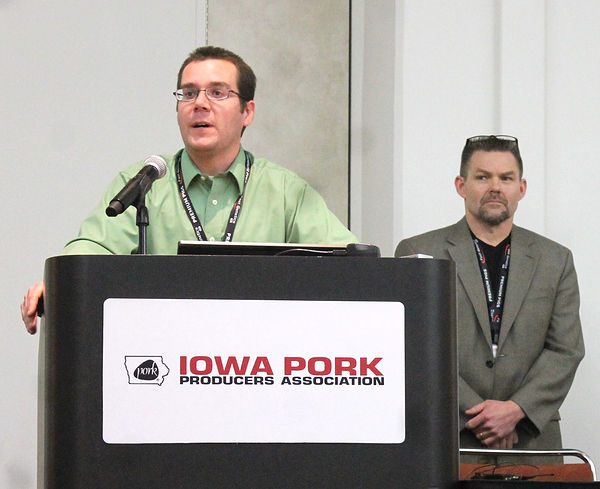A $1 million Iowa Pork Producers Association-funded research project on pit foaming has entered its third year.
Researchers provided an update at the Iowa Pork Congress in Des Moines.
“Our goal is to find and correct the mechanisms of foaming,” said Steve Hoff, an agricultural and biosystems engineering professor at Iowa State University and project manager. “We feel if we can go back far enough to see how foam forms in the first place, the marketplace will take over and identify some of those key mechanisms.”
Foam results from the accumulation of flammable gases, most significantly methane. Depending on the amount of gas that is trapped in a given barn, dangerous concentrations are possible during a sudden breakage of foam. This can result in flash fires if a spark is present.
“Attempts at correlating foaming versus non-foaming barns with multiple factors have been elusive,” Hoff said.
Foaming has occurred in one pit of side by side rooms with an equalizing channel. It is commonly found in one barn of multi-barn sites with common genetics and feed management, Hoff said.
The multi-state research effort involves 20 people with expertise in manure management, chemistry, microbiology and animal nutrition at ISU, USDA/ARS, the University of Minnesota and the University of Illinois.
Dan Andersen, an ISU assistant professor and Extension specialist in ag and biosystems engineering, said there must be a gas phase to create foam, a surfactant phase and a stabilization phase. Kicking out any of these legs provides a chance to mitigate it.
Researchers have done extensive manure collection, taking more than 2,000 samples at more than 60 sites, Andersen said. Samples from foaming and non-foaming barns were collected from the foam layer, the thin transition layer between the foam and the manure, the manure and sludge layers. They worked with two swine integrators.
Brian Kerr, lead research scientist for the USDA swine research unit in Ames, has looked at various swine diets to see how these affect biogas generation
“Biogas generation comes down to carbon coming out of the pig,” Kerr said.
Early thinking held that certain feed ingredients were associated with foaming.
“Nutritionally, the way I look at it is not a specific feed ingredient but what the feed ingredient encompasses,” Kerr said. “If you say it’s related to distillers, my opinion is it’s not the distillers per se, it is fiber. If you’re going to a higher fiber diet whether it’s wheat midds, distillers or corn germ meal, you formulate the diet a bit differently and the output will be different.”
Averaged across three trials, high fiber diets increased manure carbon by 40 percent, Kerr said.
Grinding to finer particle size resulted in improved digestibility and less manure output.
Andersen said researchers found that higher fiber feed ingredients have reduced nutrient digestibility and are increasing levels of carbon reaching the manure pit. Increased carbon increases microbial activity. Efficiencies in both the processing of new carbon inputs and fermentation of fatty acid material have resulted in increased levels of methane production.
“Higher levels of methane production have resulted in separation and concentration of biological material into a foam layer,” Andersen said. “The foam layer itself shows unique characteristics. It has solids enriched with fine particles, enhanced foam stability, higher total carbohydrates and microbial oils, and the liquid is really viscous.”
Andersen said the simplest way to manage foam is to pump barns twice each year.
Hoff said that producers need to observe precautionary measures.
“Any activity at all that disrupts the foam (like power washing), along with any ignition source within the barn space, can be a dangerous situation,” Hoff said. “Maintenance items like welding are a concern as well. Drop blankets located at least 20 feet or so around the welding location must be used. As always, any activity at all where the foam can potentially be disrupted must be accompanied by proper ventilation rates, regardless of the time of year.”
Prior to pumping, all ignition sources such as pilot lights or welders should be turned off, Hoff said. Ventilation should be set at 30 cubic feet per minute per pig space, at a minimum. This can be achieved by opening curtains where there is greater than 10 miles per hour wind. If it is calm, close the curtains and use fans and operate the ceiling inlet system. In a 1,000 head barn, that equates to two 48-inch, three 36-inch or six 24-inch fans.
Make sure ceiling inlets are operational. Vacate the barn and then finally the foam and pit can be disturbed.
There is additional information on precautionary measures from ISU, U of M and the National Pork Board.
For the original Agri News story, click here.
